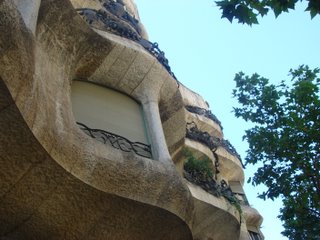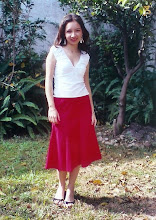
Barcelona, Day 3.
Went to bank again today. They said no bank card. That freaked me out a bit. Asked if I could withdraw money (it was my bank's branch) with my account number and my passport. They said they had no access to foreign accounts (what? Is this the 18th century? Even I can access my acount from my phone or internet!). Freaked out even more. Considered opening an account so that I could wire myself some money, but before that I decided to phone up Citibank in the US and ask where my package was by tracking number, since they'd claimed they had sent it on Friday.
Glad I did. They said it had arrived in Barcelona, at the branch I was at, at 9:23 a.m. that day, with signature of receipt. It was quarter past 10 by now, I had been at the branch only 15 minutes ago. Lucky I picked a phone just outside the subway station one street from the bank, instead of waiting until I got to the hotel at city center. Anyway, back to the branch I went.
They had it, indeed. They just hadn't bothered to look too carefully earlier. Bit it was a one-half hour of big-time stress, I tell you.
Now more tranquil and knowing I no longer had to count pennies, I went to the expensive Picasso museum. This is a pretty neat museum because it has a very nice collection of Picasso's earlier works, and it is, judiciously, chronologically organized so that you can see the development of the painter.
If you've ever, even once, just stood in front of a Picasso and thought: "Hey, I could do that!", think again. When you see the usual Picassos at the museums, they're so simple, it is easy to think this (or at least, think "I could do that" if you had the idea, since it requires some spark of geniality to come up with the concept in the first place, but let's assume you could, for I'm merely talking about "execution", here). No, my friends. Take a look at his early paintings and sketches (the museum has a fine collection of some works he did when he was only 15), and you can really see that here's some talent, one that is extraordinarily rare. The simplifications you see in his later works were not casual, not haphazard, not a result of "I can't paint in the realism style so let me go abstract and invent some weird cubist stuff and see if I become famous that way", but deliberate, studied, and careful (even though his brushstrokes are rather unrestrained and casual, the paintings themselves are not!--just take a look at some of his preparatory sketches to see the thought and care that went into them). I have never been a big fan of Picasso (I do not enjoy looking at most of his paintings), but what a great painter he was. There is method to the madness, and intrinsically tied to it, is "execution" (remember what I said art requires?). There is no doubt he was a master painter. No "I could do that too!" here at all! (I betcha, too, that he was an extraordinarily smart fellow as well).
One of the neat rooms in the museum, by the way, was the one dedicated to the 58 variations on Velazquez's "Las Meninas". (Ian, my friend: wouldn't you like to furnish a room in your apartment, with the original and the 58 variations? It would be a little visual analogy to François Girard's "Thirty-two short films about Glenn Gould", don't you think? ;) ). And about these works, Picasso had to say (taken from a note in the displays of said rooms):
"If one were to set out to copy "Las Meninas" in all good faith, let's say, on reaching a certain point and the person copying was me, I would wonder: How would it be to put this one a little more to the right or left? And I would try to do it my way, forgetting all about Velazquez. That experiment would certainly lead me to modify the light or change it because I had moved one of the characters. And so, bit by bit, I would paint some "Meninas" that would seem detestable to the professional copyist; they would not be the ones he thought he saw in Velazquez's canvas, but they would be my "Meninas" ".
(Remember what I said about making copies? :D Variation ≠ copy. That's the whole point. Nobody said that what inspires art needs to be "real" or "live", on the contrary, it often is other art itself. But, Art inspired upon art is never meant to be a copy. Never.)
Anyway, after having an awesome time at this museum (I was glad to discover a newfound appreciation for Picasso--it doesn't make me like his pictures more, but it makes the difference between, say, listening to a symphony without knowing that it is composed of 4 movements, and having taken a course in harmony and counterpoint. You appreciate things at a different level, you acquire depth of knowledge, in other words. Liking and appreciating is not the same thing at all, you see...)
Speaking of concerts, since the Palau de la Musica Catalana was nearby, I took a stroll there to try to check out its UNESCO World Heritage Site architecture. Unfortunately, there were no more tours for the day, and not only that, they were running around the 11 Euro mark, which seemed a bit excessive. A happy resolution presented itself though: the Festival de Guitarra was coming to its conclusion the next day with works by Mompou, Albeniz, and, appropriately, the Concierto de Aranjuez, played by no less than Pepe Romero himself! Wow! Opportunities like this don't come often, so what best way to kill two birds with one stone--see the theater interior architecture and listen to some excellent music while doing so? Yup, got me a ticket (it is nice to finally have your ATM card!). Are you jealous? ;)
Anyway, in the afternoon seeing as how I needed to catch up on my sight-seeing after too much lounging in the beach and partying with Dorothee and Mieko on the previous days, I headed over to Gaudì's "Casa Millá", also known as "La Pedrera", even though, again, I'm not a big fan of Gaudì's (and that's a rather large understatement). I think the reason I don't like Gaudì is that he seems to have a lot of unnecessary features: adornments on columns that bear no loads but that in my opinion also do not add to the aesthetics of them, for instance. Like it is a bit of a waste of effort (the engineer in me rebels against that). Too "Winchester house-like" for me in some works, too much like the inside of the Alien spaceship with its icky guts and all in others for me.
It was interesting, though, in "La Pedrera", to see the displays explaining how Gaudí came up with the system to make his strange architecture work (i.e. not fall down). Clearly, he was an empiricist, a person not much for mathematical calculations, as evidenced for the scanty drawings and plans he produced and the way he directed construction off plaster models. However, some of the methods utilized were very clever and simple: the funicular polygon, for instance, whereby strings are weighted with little lead balls or sand sacks proportional to the loads the arches and columns have to bear, and which explains a bit Gaudì's fondness (or perhaps, more accurately, inevitable propensity) for the use of catenary arches.
And which made me think: "Architecture and civil engineering should be meshed into one discipline". That way, I thought, too, you avoid garish Gaudí-like excesses, and produce cooler stuff like this if you are intent on imitating nature.
{shrug}

4 comments:
Don't forget, the art you are seeing is all *used* art. Wouldn't you rather have new?
Erm...perhaps if you elaborate a bit on what exactly you mean by "used art", I may be better able to address your question...
It would be fun to construct a house of mirrors with a Las Meninas theme. The orginal Velasquez would be in the middle, serving as the orginal point of reflection which would in turn give way to 58 other mirrors reflecting segments of Picasso's variations. The actual piantings would be hidden from view, but the mirrors would be arranged in such a way that the reflections would line up with the mirror within the painting.
Whaddya say? I'll write the proposal and you do the marketing? :)
Ah, Ian, my friend. I am of course very much affronted by the implication that I would even posess the ability to do any marketing at all! If you could use someone to do all the required mirror angle placing calculations, that, on the contrary, would be very much my pleasure, and seeing as how I have some rather extensive expertise in positioning and aligning small mirrors in darkened rooms to within one-Angstrom tolerances, I could even assist you with the actual placement. In this other area you will find, I think, my work quite satisfactory indeed. :P
Post a Comment